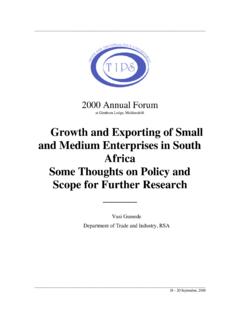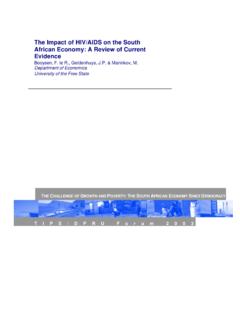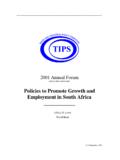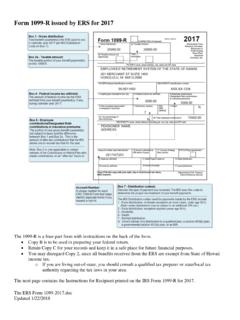Transcription of Spatial Development Initiatives and Employment Creation ...
1 _____ _____ 18 20 September, 2000 2000 Annual Forum at Glenburn Lodge, Muldersdrift Spatial Development Initiatives AND Employment Creation : WILL THEY WORK? _____ CM Naude Transportek CSIR SK McCoskey Naval Academy 1 Spatial Development Initiatives AND Employment Creation : WILL THEY WORK? CM Naude * and SK McCoskey** Abstract The Spatial Development initiative (SDI) programme has been in existence since 1995, with the primary aims of generating investment projects in key economic sectors in specific areas of the country thereby increasing Employment in these sectors and areas. The key objective of the paper is to provide an assessment of the capacity of the SDIs to restructure the economy and enhance Employment Creation in South Africa.
2 This will include the extent to which the SDI strategy conforms to economic theory on industrial location and economic Development , as well as the extent to which the SDIs have been (and can be) successful in Employment Creation . The paper includes an overview of the SDI programme, current trends in the South African economy and a review of the economic theory of economic Development in a Spatial context. Finally, the SDIs are assessed in terms of their success in creating Employment opportunities. The conclusions of the paper are as follows: The capital required by the potential projects of the SDIs are substantial when measured against their potential job Creation ( R381 000 per job on average). The issue in this regard is whether key projects should be prioritized in terms of their ability to create jobs in the near future; The bulk of the envisaged SDI projects are focused on the traditional sectors of the South African economy, Agriculture, Mining and Manufacturing.
3 Globalization and the New Economy might dictate that this emphasis be revised to include sectors which are poised for growth, Tourism, Financial & Business Services and hi-tech manufacturing. The case for this would seem to be even stronger if the hierarchy of Development is considered (see Meier, 1984), whereby economies become more dependent upon tertiary sectors and less dependent upon primary and secondary sectors for economic growth; Certainly in terms of the location of the SDI areas, it seems that the gradual widening of the SDIs to include more areas of the country has resulted in an alignment of SDIs with those areas which have experienced Employment growth between 1980 and 1996. This should ensure that the SDIs are located in areas of economic growth and the core of the economy as opposed to the periphery.
4 The extent to which government can directly influence the decision to invest could be limited because the final decision is a firm-level one. However, government could very well play a useful role indirectly in terms of influencing the structure of the firm s decision through infrastructure provision, reduction of transportation costs and enhancement of education levels. For SDIs to be successful, the importance of the legal and institutional framework supporting investment will have be favourable. An example would be the objective of creating 35,000 jobs in the agricultural and related sectors in the context of a land tax and the legal framework pertinent to Employment . * Transportek CSIR, PO Box 395, Pretoria, 0001 ** Naval Academy, 121 Blake Road, Annapolis, MD 21402 2 INTRODUCTION The Spatial Development initiative (SDI) programme has been in existence since 1995, with the primary aims of generating investment projects in key economic sectors in specific areas of the country thereby increasing Employment in these sectors and areas.
5 The key objective of the paper is to provide an assessment of the capacity of the SDIs to restructure the economy and enhance Employment Creation in South Africa. This will include the extent to which the SDI strategy conforms to economic theory on industrial location and economic Development , as well as the extent to which the SDIs have been (and can be) successful in Employment Creation . The paper includes an overview of the SDI programme, current trends in the South African economy and a review of the economic theory of economic Development in a Spatial context. Finally, the SDIs are analyzed in terms of their potential for creating Employment opportunities.
6 REVIEW OF THE SDI PROGRAMME The SDI process began in 1995 and was the first attempt by the government (primarily the Department of Trade & Industry and the Department of Transport) to take economic policy into the implementation arena. It sought to identify key areas of the country which could be the focus for economic Development in the post-apartheid era and promote investment in these areas. The areas would be identified on the strength of the core economic activities (along sectoral lines) which characterized the area and then strategies could be devised focused on these lead sectors. Anchor projects would then also be identified as being the key projects which could initiate and sustain the SDIs into the future.
7 More often than not, the SDIs encompassed existing or proposed transport infrastructure and took the form of a Development corridor. A key component would then be the active promotion by government of investment in the anchor projects in the SDIs by the private sector. The role of government would then be to identify projects and to facilitate involvement by interested parties. An overview of some of the different types of SDIs and their respective sectoral focus is provided below: Industrial: KwaZulu-Natal SDI Fish River SDI Richards Bay-Empangeni SDI Phalaborwa SDI Agri-Tourism Lubombo SDI Wild Coast SDI Mixed sectors Maputo Development Corridor West Coast Investment initiative 3 Other Initiatives are in the process of identifying projects, the Platinum SDI.
8 In addition, various centres were identified for the location of Industrial Development Zones (IDZs) to support the SDIs, Saldhana, Durban and Richards Bay. The SDIs referred to above have identified projects to the value of $32,4 billion , creating 86000 jobs. A breakdown of some of the sectors, and their direct relative potential Employment opportunities is contained in Table 1 below. Table 1: SDI capital investment and anticipated Employment Creation per economic sector Sector Number of projects Fixed capital (Rm) Jobs (min) Jobs (max) Capital required per job (Rands) (max case) Agriculture & agriprocessing 124 26,223 26,427 14,394 Fishing & marine products 10 495 3,460 1,486 Forestry 1 5,000 5,000 2,600 Automotive & transport 42 1, 7,085 11,649 129,835 Chemicals, rubber & plastics 53 8, 6,483 7,083 1,258,779 Clothing & textiles 29 2,553 2,553 11,961 Electronics 2 463 463 20,518 Energy 5 3, 0 0 Food & beverages 18 325 350 2,674,440 Furniture & wood products 23 3,030 12,000 38,055 Infrastructure 112 2, 1,135 1,395 1,872,532 Leather & footware 5 230 420 8,731 Machinery & electrical equipment 1 130 130 23,077 Metals & metal products 59 8, 13,070 13,167 679,694 Mining & minerals processing 52 2, 3,848 3,968 718.
9 247 Nonmetals & non-metallic products 11 381 381 1,242,322 Other 5 0 0 Printing, pulp & paper 2 1,200 1,200 233,333 Property Development 36 1,459 1,609 75,514 Services 13 0 0 - Tourism 165 1, 3,311 3,575 483,354 Total 773 32, 84,942 86,309 375,148 (Source: ) 4 The data in Table 1 depict the capital involved per sector for the various projects for the SDIs and estimates of the respective numbers of Employment opportunities for the projects in the various sectors. The capital cost per job varies considerably across the sectors, R1,486 per job in the case of Fishing and Marine products, to R2,674,440 per job in the case of Food & Beverages, with an average of R375,148 overall. The figures might seem rather high on average, but do indicate the immense requirements of capital needed to create jobs in the South African context.
10 The opportunity cost of investment in projects in the SDIs is an important issue. The decision to invest by the private sector in the SDIs would hinge upon whether the returns are better in these (SDI-based) projects than in alternative (competing) investments both in South Africa and abroad, subject to criteria deemed critical to investors. Government would not automatically be involved in the projects, if at all. REVIEW OF ECONOMIC THEORY The part of economic theory most appropriate to analyzing economic activity ( Employment Creation ) on a regional or Spatial basis is that of the new economic geography . This school of economic thought attempts to explain economic Development in terms of history and accident (non-economic factors, political developments), the geographic location of industries relative to their suppliers and markets, advantages accruing from concentration of industries ( increasing returns) which perpetuate industrial patterns over time long after the initial rationale for the location has diminished, identification of a core and periphery of an economy which may change over time.











